Above: The St. Luke’s bell tower in 2023. Photo by Taylor Wilkey.
(Author’s Note: This is an update of the article published in the East Greenwich Magazine, June 1998, by the same Author)
By Laura Sullivan
Ring the bells that still can ring
Forget your perfect offering
There is a crack, a crack in everything
That’s how the light gets in.
– Leonard Cohen
It is one of the outstanding landmarks in town: the slender granite finger on the Hill’s skyline, pointing to the heavens. Whether viewed as a homing beacon for mariners out on the Bay, or seen rounding the bend on Post Road coming in from Warwick, the elegant steeple of St. Luke’s personifies the architectural beauty of East Greenwich.
This notable focal point has only been a part of the scene for a small fraction of the Town’s history, however. Erected and dedicated in 1923, St. Luke’s will celebrate the 100th anniversary of the building of the tower, and the installation of the chimes, on Sunday, June 25, starting with the 10:15 a.m. service, followed by a reception in the courtyard, and a short bell concert, similarly marking the Dedication and Celebration events of 1923. Over the next five Tuesday evenings, through July 25, there will be Twilight Bell Concerts, starting at 7 p.m., and featuring both veteran and apprentice chimers.
 The Tennessee marble tablet, seen from the Church Street side, reads that the Spire and Chimes are given in memory of Daniel Goodwin, ‘Priest and Doctor and Rector of this Parish, 1879-1892’, by his widow. Dr. Goodwin died in 1922, and funding, in addition to Mrs. Goodwin, was provided by his brother-in-law, Daniel Peirce, for whom the street is named, and who also provided the bequest for the East Greenwich Free Library across the street.
The Tennessee marble tablet, seen from the Church Street side, reads that the Spire and Chimes are given in memory of Daniel Goodwin, ‘Priest and Doctor and Rector of this Parish, 1879-1892’, by his widow. Dr. Goodwin died in 1922, and funding, in addition to Mrs. Goodwin, was provided by his brother-in-law, Daniel Peirce, for whom the street is named, and who also provided the bequest for the East Greenwich Free Library across the street.
Dr. Goodwin was much loved and respected in his lifetime, and in his many roles as priest, rector, senior presbyter of the diocese, historian, scholar, and more. His tenure as rector at St. Luke’s was notable in expanding the parish’s mission outreach to the community, and establishing many organizations within the parish, thus creating multiple opportunities for lay leadership that have been sustained and have grown, a century later.
Among the many tributes following his death at “Sunnybanks,” his Cowesett residence, on Aug. 28, 1922, was a resolution by the vestry of St. Luke’s:
“…his continued residence here was a constant benediction to parish and all people; the good work begun as rector suffered no lapse in his remaining as counselor and friend; and the memory of his gracious personality will continue an inspiration to all who bear the burden and heat of the day.
“He was a man of unusual literary tastes and gifts, of deep culture and spiritual grace. Without him our work in the Church Militant will be lonelier; but we are sure that his reward must be great in the Paradise to which he has gone.
“To his widow we tender our heartfelt sympathy, with the prayer that God, our Father, may abundantly comfort and bless her.
Attest: William A. Browning, Clerk”
Dr. Goodwin’s funeral was held at St. Luke’s on August 31, followed by burial in the northwest corner of the churchyard.
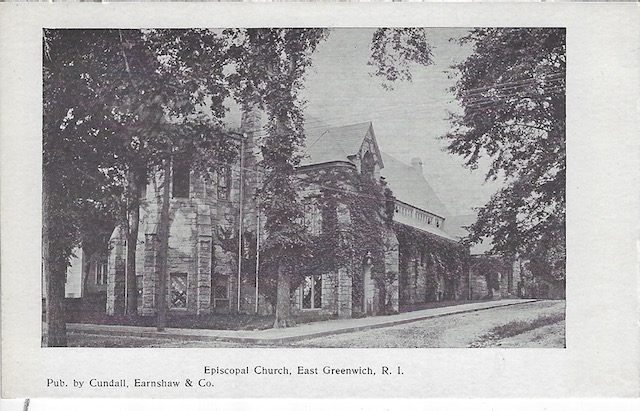
A postcard of St. Luke’s before the Tower
Only weeks later, an October 12 editorial in the Rhode Island Pendulum noted the bequest of Mrs. Goodwin, and the impact on the community:
The Music of the Chimes
The recent gift of a set of chimes to St. Luke’s Church by Mrs. Daniel Goodwin in honor of her late husband is a reminder to us all that there is something more in life than the weekly pay envelope or the returns from coupons.
The man of moderate means needs to be reminded in these days when wealth is being featured in nearly every newspaper one picks up that most of the enjoyment and real value in life can be secured by moderate means. The craze to make a big fortune at any cost is a specie of insanity…
The man who is the richest in a community is the one who can get the most out of the so-called common experiences of everyday life and who serves his fellow men the best.
So much emphasis is placed these days upon the possession of material wealth it is a source of great satisfaction that the residents of East Greenwich are to hear in the near future after the tower can be built and the bells installed, the harmonies of clear toned bells. Is there anything more stirring to one’s imagination and memory than the music of the chimes? Old landmarks serve the mariners of several generations in guiding their ships home. A set of chimes in a city or town serves the same purpose and serves as a reminder of community life as almost one other thing will do. It was a happy thought which inspired the gift of the chimes.
A handwritten list of “Chiming Days,” included in the Goodwin bequest, stipulated that the bells be rung, in addition to Sundays, on the following holidays and special dates:
- March 10: Birthday of Daniel Goodwin
- Memorial Day
- July 4: Independence Day
- August 9: Birthday of Emily Vaughan Peirce (Mrs. Goodwin’s sister)
- September 22: Birthday of Mrs. Daniel Goodwin
- Thanksgiving Day
- Church Festivals:
- August 6: Transfiguration
- September 29: St. Michael & All Angels
- October 18: St. Luke’s Day
- November 1: All Saints Day
- December 25: Christmas Day
- January 1: New Year’s Day
- January 6: Epiphany
- Ash Wednesday
- Maundy Thursday
- Good Friday
- Ascension Day
Over the following months the view up the Hill changed, as first the tower appeared, topped by the spire, and then by a copper cross, at a total height of 95 feet. Like the rest of the church, and the library, the entire steeple (tower and spire) is constructed of Coventry granite from the former quarry at Carrs Pond, on the western border of town.
Architects for the construction were Providence-based Clarke & Howe, active from 1893-1928. Other buildings in the state designed by the firm include Kinney Casino (Bungalow) in Narragansett (1900), St. George’s School, Middletown (1901), U.S. Federal Building in Kennedy Plaza (1904-08), The Oaks (Goddard Estate), Potowomut (1902, since demolished), St. Elizabeth Home, Providence (1915), St. Martin’s, Providence (1916-17) and Marvel Gymnasium, Brown University (1928, since demolished).
Comprised of eleven bells – encompassing an octave in the key of F, plus three extra bells to facilitate the playing of pieces in the keys of B-flat and C – the chimes were manufactured by the Original Meneely Bell Foundry in Watervliet, N.Y. The weight of the bells, including the frame and mountings, totals 6 ¼ tons. The Great Bell (the F bell) alone weighs over a ton, and is 47 inches wide; while being chimed, it stands stationary, but can also be released from its chime connection to be swung like a traditional church bell.
Each of the 11 bells bears an inscription, with the largest F bell (the Great Bell) proclaiming the dedication to Dr. Goodwin, followed by “To live in hearts we leave behind is not to die.” While nine of the other bells are etched with individual verses from Scripture, there is one inscribed:
“Be the day never so long
At last it ringeth
To Even Song.”
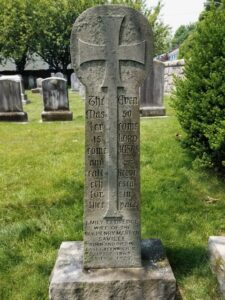
The gravestone for Emily Eldredge Saville. Submitted photo
This inscription, a paraphrase of a sixteenth-century proverb, was suggested by Emily Eldredge Saville (1869-1923). According to Anne C. “Nancy Allen” Holst of Cowesett (1908-1997), a local historian, Emily was the granddaughter of Dr. James H. Eldredge (for whom the school is named) and great-granddaughter of Dr. Charles Eldredge, one of the founders of St. Luke’s in 1833. At age 7, Emily spent a summer at her grandfather’s home at the corner of Peirce and Division streets, writing her memoirs of that summer (ca. 1876). These musings were later published in a book, “Memories and A Garden” by her husband in 1924, a year after her death. In the book, Emily reflects on a visit by the rector with her “Grandmamma” and “Aunty Nan,” when the subject of bells at St. Luke’s was discussed:
After dinner Grandmamma and Aunty Nan and Dr. St. John [Emily used fictitious names for many actual persons in her accounts: this was likely Rev. George Pomeroy Allen] sat in the library, and when they had had their coffee they buried themselves in a book about bells. Grandmamma was very much interested in bells, and they were hoping to have one in the Church tower. Rung before Service they summoned the Angels and scattered the evil spirits, she told me.
“How is this,” she said, “beginning, ‘Laude Deum Verum’, and ending, or this, ‘In Hora Mortis Meae, Voca Me!’
Dr. St. John drew his bushy eyebrows together, and stuck out his lower lip, “How’s this for plain English? ‘I ring to sermon with a lusty boom, – That all may come and none may stay at home.’ And I had an idea that he was looking at me.
Despite the spirited conversation regarding the installation of bells in the “new” St. Luke’s Church, dedicated that year, it was 47 years before the Tower and Bells became a reality. Nevertheless, Emily’s suggestion of the poetic inscription on that bell was acknowledged, and is a tribute to her, buried below in St. Luke’s Churchyard.
Of special note is another bell which had been stored in the basement of the church since 1876, when the current church building was erected. The large bell had been purchased by the citizens of East Greenwich for the Catholic Congregational Church, which had occupied the site prior to St. Luke’s incorporation in 1833. Placed in the belfry of the first St. Luke’s Church building in 1834, there was no suitable location for it in the present neo-Gothic structure, and the Goodwin bequest of the chimes made the single bell unnecessary. Therefore, in 1942, it was decided to return the bell to the Congregationalists, its original denomination. Rev. Charles Meader, retired Rector of St. Luke’s, made the presentation to the Beneficent Church, in Providence, as they marked their 200th anniversary. The bell was later hung in a belfry of an addition to the church, over Chestnut Street, where it is in use today.
To reach the console where the bells are played, the nimble chimer must climb a narrow, wooden spiral staircase to an area about 10 feet below the bells themselves. Such a setting lends itself to a romanticized picture of Gothic intrigue, but the skill and energy required to produce a melodic wave over the town is not for the weak of heart. Over the decades, many have stood at the console, during all times of the year, in all types of weather, at holidays and holy days, to cast the notes into the wind.
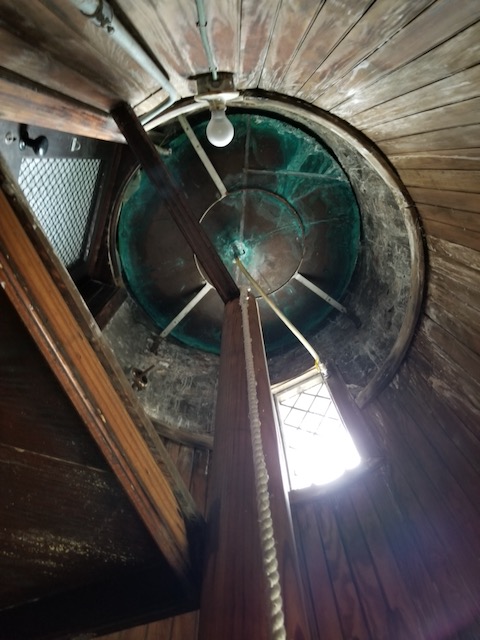
Tower Staircase looking up to Copper Baffle. Submitted photo
While many who have stood at the console to play have passed on, their recollections endure, including those who offered their thoughts for the 75th Anniversary:
Thomas Casey Greene (1931-2021), of Potowomut, began as a chimer when he was about 12 years of age, during the 1940s. “The Town was much smaller and quieter then,” he recalled. “You could hear the distant chimes [at home in Potowomut] when the wind was right.” Instructed by Louise Windsor, a former organist and choir director, he became proficient in ringing the changes – the sequence of running notes that often served as an introduction, an interlude, or a conclusion of a chiming session. He remembered the elm trees that lined Peirce Street, “curling around” the steeple. During the Advent and Lenten seasons, the bells were played at dusk every day; and it was a “true Episcopal feeling” to venture up the feebly-lighted stairs in the chill of evening to fulfill his liturgical obligation.
A 1943 church leaflet of War-Time Prayers states: “The chimes of St. Luke’s will ring every evening during Lent at six-o’clock as a call for all people of the community to join in solemn prayer for our Country, for those who are serving her on land, sea and air, and for the peace of the world.”
In those days, the small door at the base of the steeple was never locked, to offer sanctuary for quiet meditation in the Church, and one could park right there on Church Street and enter in, which was very convenient for the chimer du jour. However, Tom remembered how that practice changed, when one year, on New Year’s Eve, a few parish teenagers climbed the tower and rang the bells at midnight. “There was a great stir, and it was quite a scandal,” he chuckled. The incident contributed to the subsequent caution of locking the church doors after hours.
Just after Midnight, Jan. 1, 2000: Two parishioners, living just down the street, accessed the darkened Church and ascended the wooden steps to play “Auld Lang Syne” on the bells, welcoming in the 21st century, and fulfilling one of the ‘Chiming Days’ in the original bequest. Reportedly, there was little stir, and no scandal.
Tom also recalled faithful parishioners, long since gone, who were ‘notable’ chimers: Alice Emmons, who maintained her elegant composure by chiming in her fur stole, and Eleanor Washburn, who “loved chiming,” and “was very good at it.” In 1950 Mrs. Washburn put together a handwritten chiming book, based on the 1940 Hymnal, with transpositions of all the hymns to the keys of the tower chimes. The looseleaf-bound book, water-stained and dog-eared from decades of use, has since been retired as other scores, with the numbering of the 1982 Hymnal, are now in use.
Dorothy Miller (1915-2009), a lifelong East Greenwich resident and parishioner, also served as a chimer during Advent and Lent. She recalled when, if she made a mistake during the ringing, she would run downstairs afterwards and look out on the street, hopeful that none of her friends were in the area who might have heard her blunder.
Jerry White (1924-2007), another lifelong East Greenwich resident and musician, most likely holds the record to date for faithful chiming. Like Tom Greene, Jerry was instructed by Louise Windsor, and started ringing the steeple bells in his youth. Jerry continued to ring the bells for decades hence, up until his death in 2007. Most notably, on Memorial Day and Veterans Day, Jerry could be counted on to play some patriotic tunes when the East Greenwich Parade ceremonies had concluded below at the Town Hall/Courthouse.
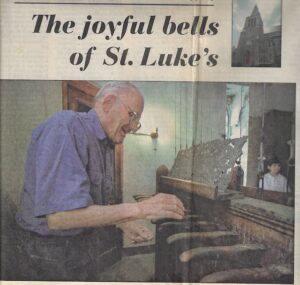
Jerry White playing the bells in 1998, from an article about the bells in the Providence Journal.
Jim Tingley (still with us!), who grew up in the area and now lives in Maryland, took his turn at the console during the 1960s and 1970s: “The rack (console) itself was and is a pure work of art with its wooden handles and locks to keep the B flat, B natural, E flat and E natural handles suppressed down out of the way, depending on the key you were playing in. It was definitely significant because you played by feel, knowing where the right handles should be.
“I rang the chimes for the Bicentennial at 2 p.m. on July 4, 1976 [with Jerry White],” Jim continued, “… one little thought in the back of your head as you rang the chimes was that not only everyone in town could hear if you made a mistake, or played well, but often the sound would carry out over the Bay, St. Luke’s being up on the Hill…. It made you really concentrate on hitting all the right notes and the right tempos.”
June 21, 22 & 23, 1998: The 75th Anniversary of the Tower and Bells was celebrated in the spirit of the original 1923 Dedication. That Sunday evening,
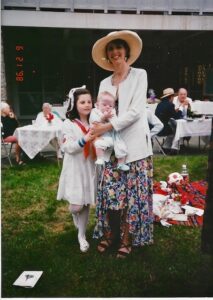
Elizabeth McNamara with children Catherine and James at the 75th anniversary picnic. Submitted photo
June 21, parishioners and guests gathered on the eastern lawn of the Parish House (before the 2000-01 expansion of the Parish House and addition of the Chafee Loggia) for a Parish Picnic. Attendees sported 1920s-era attire, and Joe Serdakowski serenaded the diners with vintage tunes on the piano, candelabra included, just inside the Dining Room. Following the supper, the Tower Bells rang forth for a Twilight Concert, with several chimers taking turns at the console. From 9 to 11 p.m., a spotlight, borrowed from Academy Players and plugged into an outlet at the Library, shone on the Steeple, monitored by an intrepid group of volunteers.
The Twilight Bell Concerts and lighting of the Steeple continued for the next two nights, with other chimers taking their turns. While the repertoire was mainly hymn tunes, ancient and more recent, there were a few songs by the Beatles heard floating over the town, among other secular melodies. Memories were made during that celebration, as heightened appreciation of the Goodwins’ gift inspired more chimers, and raised hopes of a more permanent lighting installation to illuminate St. Luke’s as a round-the-clock “Light on the Hill.”
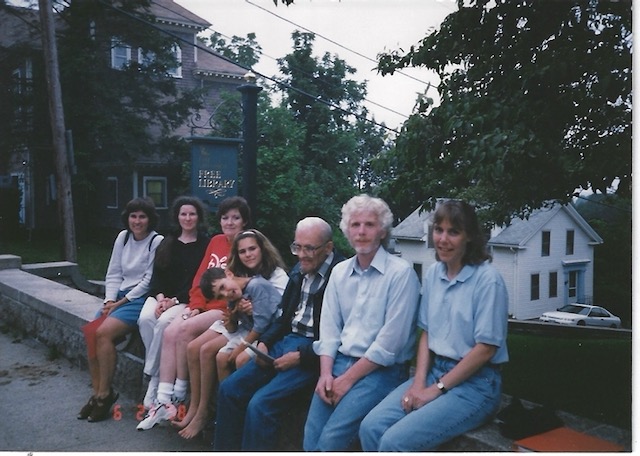
The volunteers in charge of manning the light shining on the tower in 1998. Submitted photo
March 2, 2003: At the request of Governor Donald Carcieri, all the church bells in the State rang once for each of the victims lost in the Station Fire on Feb. 20 in West Warwick. Several parishioners ascended the steps that Sunday morning, following the service, and took turns ringing for the 97 victims. That afternoon it was learned that another soul had died; two more would perish in the coming weeks, bringing the total to 100.
Over the following decade the ringing of the bells became less frequent, due both to the limited number of chimers available and, more significantly, to the deterioration of the Tower, caused primarily by water damage, as wind-driven rains filtered in. Part of this structural deterioration was due to some of the external louvers/slats in the Tower. A 2010 campaign brochure, titled “Restore, Refresh, Renew” listed multiple concerns and repairs needed to both the Church and the Parish House, including the Bell Tower. The punch list for the Tower read “…remove existing damaged louvers and replace with granite or other suitable louvers. Finish room at bell ringing station… It was begun 10 years ago and sits abandoned; possible use as classroom for chime-ringing instruction or other use. Funds could be supplemented from chime maintenance endowment account. Rebuild spiral stairway to room from sacristy (dangerous and needs work).”
2009-2010: In response to this campaign, and fueled by the concern and insistence of Priscilla Adams Rigg (1929-2019), the director of music and organist at the time, funds were withdrawn from the Chimes Endowment Fund to repair/replace the broken/damaged slates in the tower and the surrounding roof. Around this time, the bells are heard more often, as more chimers, young and not-so-young, signed on to ring on Sundays, and other various occasions.
2012: Upon approval by the vestry, additional funds were allocated from the Chimes Endowment Fund to repair and rebuild the chiming stand/console, and replace the connecting cables leading up to the bells.
2015: Following a lightning strike in August, the insurance company requested that a structural engineer be called in to ascertain any damage to the Steeple. While no damage from the lightning was detected, a pair of critical steel support beams was found to be severely rusted and corroded, thus compromising the stability of the south wall of the Bell Tower, and the spire above, especially if winds exceeded 30 mph. The detailed report of the inspection was shared with the rector, the wardens and members of the Property Committee. Out of an abundance of caution, the vestry met and decided that Sunday services would be held in the Parish Auditorium until repairs could be done to stabilize the structure.
On Oct. 1, with a tropical weather forecast of heavy rains and high winds, Rev. Timothy Rich notified the Parish community that, after meeting with Town officials, it had been decided to close the entire Parish campus for the upcoming weekend. Accordingly, areas around the church were cordoned off, including sections of Church and Peirce streets, and the library. The situation made the evening news, as Fr. Tim was interviewed by local media outlets. Choir rehearsals moved to the United Methodist Church, on South County Trail. Sunday services were held in the Swift Community Center, just outside the restricted perimeter, on Sunday, Oct. 4. A reassessment of the Tower the following week determined that it was still structurally vulnerable, so Church services resumed back in the Auditorium, while the rest of the campus and surrounding area could reopen.
Less than a week later, with another threat of high winds, services on Sunday, Oct.11, services were held at the Greenwich Odeum on Main Street, where St Luke’s was welcomed on the marquee.
Recognizing the need to address the safety issue, a two-part program was quickly undertaken, starting with the request for bids from contractors. Phase One would address the immediate need to shore up the tower to make it safe for occupancy in the church and the surrounding area. With the Vestry’s approval, the Isaac Blair Company and Marr Scaffolding, out of Boston, were hired to do the work, with the Damon Company of Newport as project manager. Under the watchful and dedicated eye of Paul Brookes, who served as St. Luke’s point person, scaffolding and staging were raised around the steeple in mid-October to facilitate the repairs, which also involved masons and roofers. Granite stones were carefully removed so that the steel beams could be inserted via a needling” technique. One of those beams, positioned across the ceiling of the chiming chamber, can be seen protruding from the eastern and western sides of the Tower. Several others, on the southern wall, were inserted into the louvers of the belfry, and across to the roof above the church nave, are so are less visible. These “needles,” in turn, were additionally shored up by a system of heavy wooden blocks and jacks to provide even weight distribution and fully support the south side of the Tower.
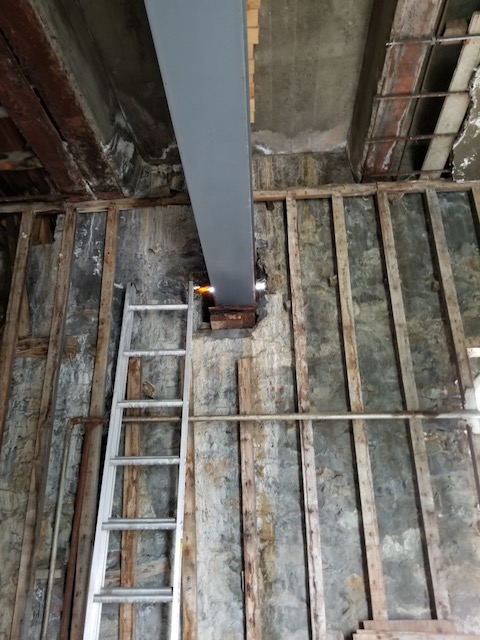
The steel beam piercing west wall of tower Submitted photo
Following an inspection by the consulting engineer and the Town’s building inspector, it was determined that the Tower was adequately supported, with no further threat of structural failure. Consequently, the All Clear was granted to occupy the entire church building, without restrictions, until more substantial and permanent repairs could be done as Phase Two. All was well, even as cracks of light could be seen between that supporting beam and the sturdy wooden blocks in the chiming chamber. Thus, on Sunday, Nov. 22, just before Thanksgiving, services resumed in the church, and the weekly Tuesday Bell Concerts, with Bruce Dearnaley at the console, were heard once again over the town.
Sunday, March 15, 2020: The COVID-19 Pandemic created a far different reason for the bells to cease ringing. At the request of Governor Gina Raimondo, and the strong urging of Bishop Nicholas Knisely, in-person services were suspended indefinitely. Nevertheless, as the world sadly and uneasily settled into a “new normal,” Bruce Dearnaley came into the empty church to play on Tuesday evenings. Even on Christmas Eve, 2020, with no joyous services below, he was there, as told in an EG News interview on May 21, 2021:
“I was up here all by myself and I played an hour and 20 minutes with the Christmas songs, because I said this will not be looked at as a dead dying forgotten parish. It’s a vibrant parish. We’re still alive, we’re still doing things. COVID has limited it…but that was one of the most meaningful nights. It took a somber, sad, desperate, desolate time, and changed the church into being alive.”
Two years after that interview, as the world has emerged from under the pandemic’s cloud, Bruce continues to ascend those wooden steps to the chiming console.Invited by Priscilla Rigg about 13 years ago to learn the bells, he carefully labeled each bell’s lever with its corresponding note, and put together a book of over one hundred hymns and other tunes, also clearly marked. He takes special care of the grand instrument, ensuring that the entire console is protected from the weather and other debris by covering it with tarps each time, upon his departure.
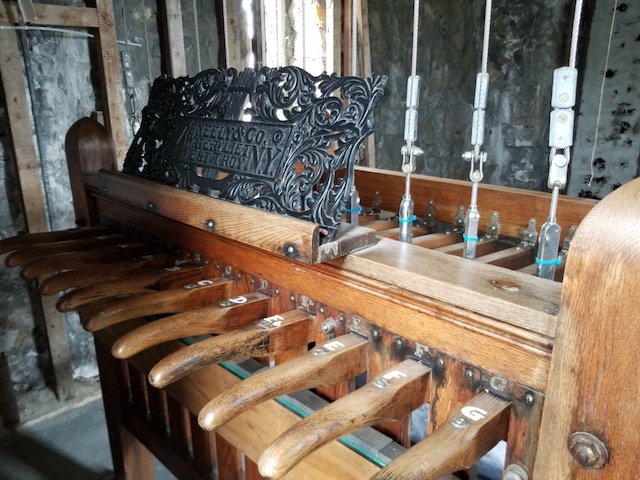
Dr. Bruce Stevens, another veteran chimer, was also invited by Mrs. Rigg to ring the bells:
“Having played a variety of instruments in band and orchestra, I thought why not. The bell desk is not like anything I had ever seen, but after a little instruction from Priscilla, it became fun to play hymns and other tunes on the bells. Thanks to Bruce Dearnaley, we are now able to keep pigeon feathers and other debris off the bell desk.”
In preparation for the Centennial Celebration of the Tower and Bells, and to look ahead to future generations of chimers, an apprentice program was launched, inviting other parishioners to learn to play the chimes. To date, at least eight apprentices of all ages – including three from St. Luke’s St. Cecilia [childrens] Choir – are ascending those wooden steps to discover the art, and the joy, of playing those bells, under Bruce Dearnaley’s tutelage.
Stacey Nakasian, one of the adult apprentices, reflects on the impact of the bells:
“The church I attended as a child sat on a hill in the middle of our village. After Sunday service, as everyone flooded onto the commons outside, the bells would ring out with a triumphant song. The sound was both affirming and energizing. And, I like to think, inspired the whole village. The music that bursts from our bell tower at St. Luke’s has the same effect on me and, I hope, on our East Greenwich community. I am thrilled to become a bell ringer and continue this tradition.”
A recent story on the impact of the Eiffel Tower in Paris, told by NBC’s Kier Simmons, stated that the structure delivers “a message from the past about believing in the future.” Surely Dr. Goodwin, slumbering in peace in the Churchyard, with a wonderful view of the Tower and Bells, dedicated in his honor, would agree.
“…And what is that above the line of Dr. Goodwin’s path that now o’ertops the trees? It is a spire, a cross-crowned spire. That is the consummation of it all, the memorial to our friend’s life, spent in the happy garden in sweet companionship and in years of faithful ministry. The eye rises above all his earthly cares and joys to this the symbol of his deepest creed. The spire and the bells and the cross embody his life of hope and joy and love.”
– From “A Memoir” by Rev. Samuel S. Drury, nephew of Dr. Goodwin, 1923
Laura Sullivan lives in East Greenwich, within earshot of the tower bells.

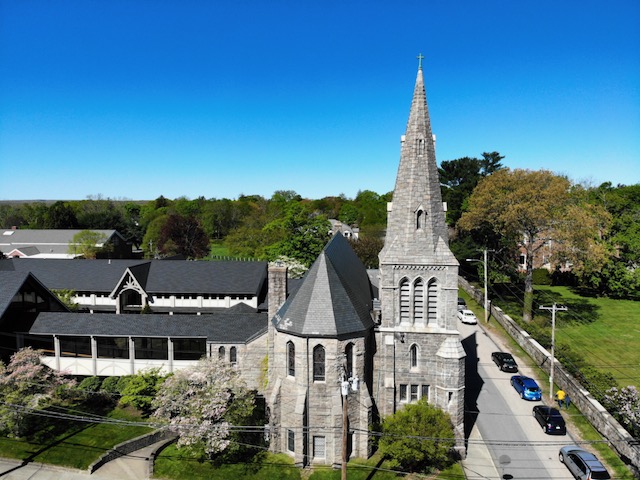

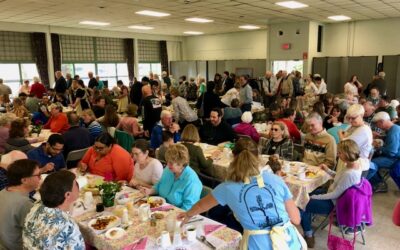
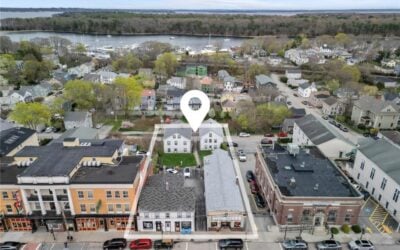

 Subscribe
Subscribe
Wonderful tribute to a beautiful history of the tower. It’s comforting to hear the bells played. Thank you, Laura
Thank you for this wonderful article. What an inspiring story of hope and determination. I’m thrilled that young people are helping to continue the tradition.
Excellent article! Thanks for sharing this history.
Thank you, Laura, for writing the story of the Bells of St Luke’s. So interesting and engaging.
When the bells are played they cast a spell, moving hearts, uplifting spirits, and bringing together all who stop to listen and reflect. A community of listeners! Imagine.
Very a-pealing story, Laura!
How blessed are we, and EG, that Laura Sullivan remembers and cares!